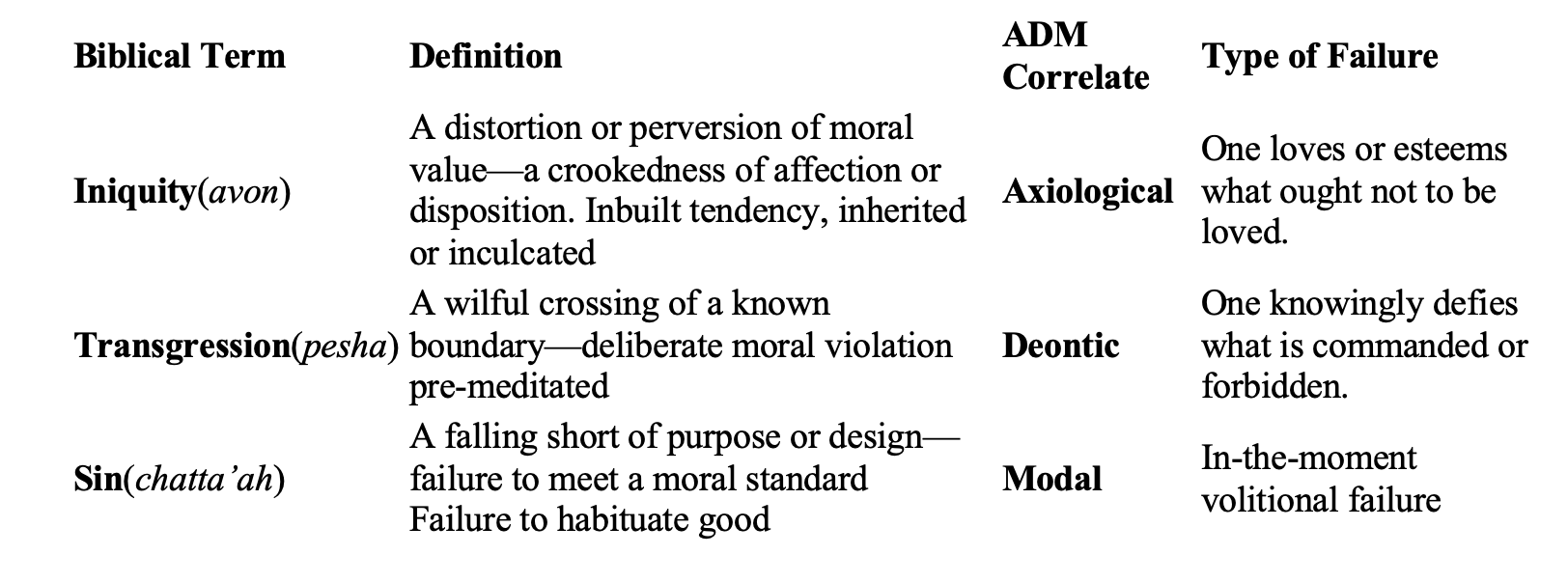This section examines the axiological root of moral failure, tracing how biblical categories such as iniquity, transgression, and sin correspond to distortions in the deontic–modal (DM) structure embedded in human moral awareness. Moral collapse is not a generic fall into error; it is a structured unraveling—beginning with a rejection of what is supremely good (iniquity), proceeding through defiance of what must be done (transgression), and culminating in concrete acts that violate God's order (sin). These dimensions are not merely behavioral—they correspond to deeper tiers of moral distortion: the noetic posture of the heart, the noēsis of intention, and the praxeological expression of disordered will. We also map these to categories of law for practical application.
While deontic and modal categories describe moral obligation and volitional response, both are rooted in prior axiological alignment—that is, whether one rightly values what is good. Hence, iniquity is not merely one kind of failure, but the root distortion from which transgression and sin flow. Scripture repeatedly affirms that not all moral failures are alike. In Psalm 51, David does not offer synonyms for wrongdoing, but distinguishes the nature of his guilt with theological precision:
“Wash me thoroughly from mine iniquity, and cleanse me from my sin. For I acknowledge my transgressions…” (Ps. 51:2–3)
Each term corresponds to a different kind of moral distortion:
This hierarchy is reinforced in Isaiah 44:22, where the relational gravity of each failure is described metaphorically: “I have blotted out, as a thick cloud, thy transgressions, and, as a cloud, thy sins…” The metaphor is intentional:
This suggests a graduated weight of guilt: transgression carries greater moral mass than sin, being premeditated and more resistant to repentance. Similarly, Isaiah 1 captures the progression of moral collapse: “Ah sinful nation, a people laden with iniquity, a seed of evildoers, children that are corrupters: they have forsaken the Lord…” (Isa. 1:4)
The people are not only sinning—they are bent in desire, defiant in behavior, and corrupted in their relational fidelity. These categories map precisely to the Axiologically inspired Deontic-Modal structure:
The axiologically-inspired and anchored DM unit is more than a taxonomy of clarity; it is a diagnostic lens. Scripture’s triad—iniquity, transgression, sin—maps exactly onto the DM axes of value, duty, and volition. Moral collapse, therefore, is not one blur of failure but a layered disintegration: motive warps first (iniquity), intent rebels next (transgression), and action finally deviates (sin).
Seen together, these layers prove that biblical morality is stratified, not flattened. Each axis exposes a distinct distortion—axiological, deontic, or modal. And when value itself is refused, the slide toward effigiation begins: the agent can still mimic moral posture, yet does so severed from ontological fidelity.

This framework not only clarifies the nature of each failure, but also points to the appropriate form of restoration—whether through value realignment (to resolve iniquity), covenantal re-submission (transgression), or the re-habituation of moral will (sin) Thus, iniquity originates in a posture of distorted valuation; transgression reflects the active decision to planned rebellion; and sin describes moral breakdown in the execution of what is known to be good or required, not premediated, but in the moment.
Having located the failure ontologically, we now trace how it manifests in the interior process of moral cognition.
Building on the four failure points previously derived from the Moral Taxonomy section—noesis, posture, disposition, and volition—we can now incorporate phenomenological terms that describe the structure of moral cognition and volition.

These internal layers of failure map not only to behavioral patterns but to ontological posture—whether one lives in submission to divinely instanced moral types, or constructs a self-referential simulation of virtue. See also section III in Moral Taxonomy.
Modern legal systems assess degrees of guilt not just by what is done, but also by the actor’s mental state. These map elegantly onto the DM-biblical framework:

While secular courts may distinguish these for procedural fairness, biblical morality treats all three as relational ruptures—requiring not only recompense or restraint, but realignment of the inner moral compass.
This tri-axial moral framework—blending biblical insight, phenomenology, and legal correspondence—offers profound diagnostic clarity:
Each of these layers corresponds to a specific aspect of the Axiological-DM unit, and each must be confronted differently:
In a world that often reduces morality to mere consequences or outcomes, this model restores the layered, typologically anchored, and relationally accountable structure of moral discernment. Only then can the moral self be reconstituted—relationally, cognitively, and practically—in fidelity to the ontological structure God has decreed.
Diagnostic Note: The Axiological Root of Moral Failure does not constitute a conceptual kind to be tested—it is the ontological breach of kindhood itself. Every moral collapse emerges from the rejection of what God has fixed, fractured integrity, excessive conceptual inflation, breakdown of typological coherence, modal presumption, misdirected telos, or defiance of divine assignment. Thus, the seven ontotype criteria not only define true kinds, but expose the precise texture of moral rebellion when those kinds are resisted. This section, then, functions not as theoretical analysis, but as ontological triage.
Summary
Moral failure, in this model, is not reducible to external behavior; it is the relational disintegration of the soul across the axiological–deontic–modal structure. Iniquity arises when the good is despised; transgression when duty is resisted; sin when misaligned desire becomes enacted will. Each maps to a breakdown in the internal moral architecture: a corrupted valuation, a rebellious intention, and a disordered act. The recovery of moral coherence, then, begins not with behavior modification, but with a restoration of love for what is truly good, submission to what is right, and dependence on what is divinely enabled. Only then can the moral self be reconstituted—relationally, cognitively, and practically—in alignment with God’s revealed order.
